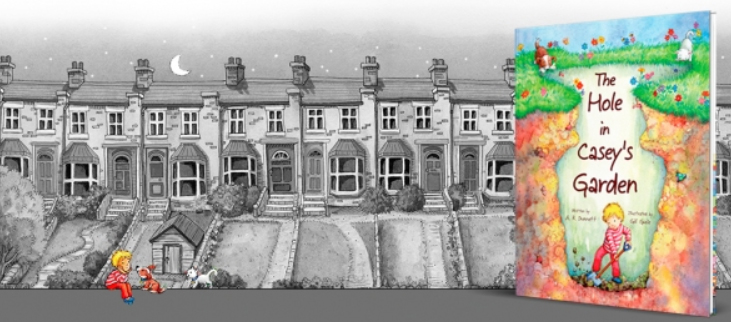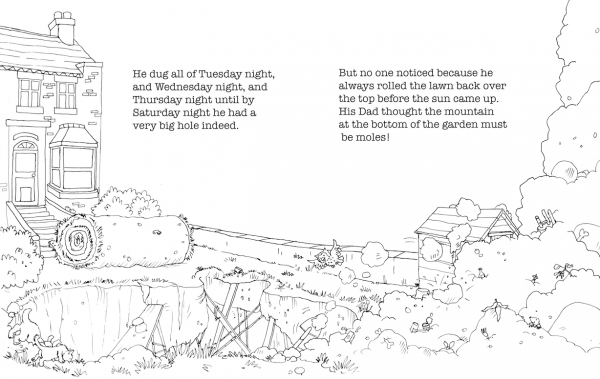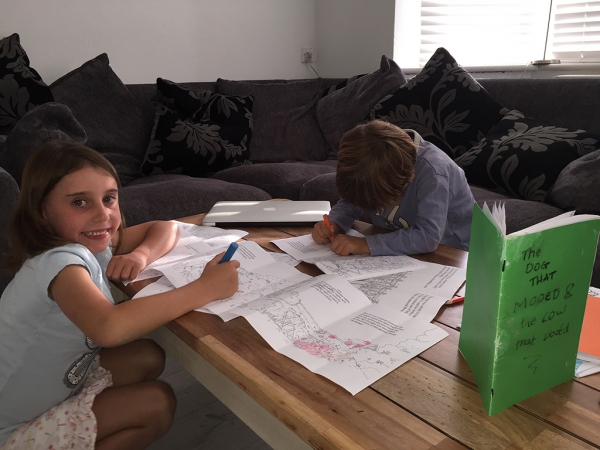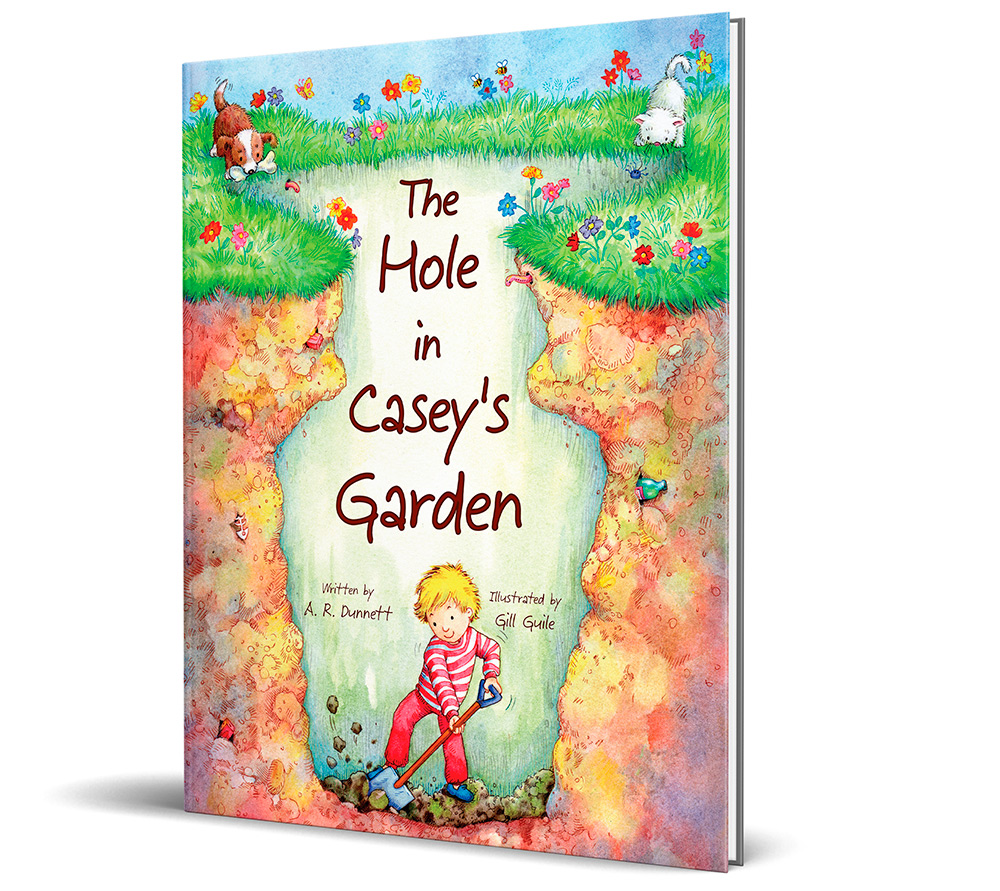
Writing a children’s book is easy…
Over the last few years I’ve gradually shifted from being mostly a stay-at-home dad, who did a bit of dreaming up stories on the side, to what I am today: A full-time writer, albeit one who does a bit of childcare too. Most of the time this arrangement is fine. But this isn’t instagram, so I won’t pretend family life is perfect. Some of the time it feels like a warzone. But generally I recognise how fortunate I am.
But it does force me to adhere to the rather unnatural school-holiday schedule. When half-terms or the long summer break comes along it’s me that has to pause whatever project I’m working on, and try to pick it up again six weeks later, when I’ve forgotten all the good bits and I’m exhausted after six weeks with the kids. The fact that holidays are expensive, and authors don’t earn much (and even less when they can’t work) doesn’t really help with the stress levels.
So one summer I decided to solve all these problems by combine my responsibilities as a writer and a dad. I told the children we would would write, illustrate and publish our very own children’s story book. After all, I’d written, and even sold, a few books by then. And I was an experts in reading children’s stories by then, I did it every night. So how hard could it be?
My daughter Alba was six at the time, my son Rafa was four. It turned out that she was just the right age for this kind of activity, and was enthusiastic about it from the start. Rafa meanwhile was a bit too young. He joined in for a while, but half-heartedly. Then he wandered off to scatter painful pieces of plastic around the floor. Or ‘play’ as he calls it.
So it was Alba and I who got stuck in. We first made a large pile of the books she liked, and another large pile of the books she didn’t like. We discussed at length why she put certain books into each pile. I then went through her pile and highlighted the ones I liked, and quietly removed the ones I was heartily sick of.

Of the remaining books we then counted the number of words on each page, and the number of pages in each book. It turned out that 32 pages was a pretty standard size of children’s picture book, and that between 600 – 800 words was about the going rate. We also noted that many of the books in the ‘good’ pile were written by an author named Julia Donaldson. I then decided to google Julia, and the first search result explained she has a net worth of fifty eight million dollars. Things were looking up.
Suitably encouraged, we sat down to write our own story.
At which point we discovered it’s harder to write a children’s story than it looks. Or at least, it’s hard to write one where the beginning matches up with the middle and the end. Or that even has an end. Or that just isn’t a bit… weird. Or too similar to another story by a very famous author who might notice, and issue legal proceedings. But after a lot of brainstorming, and many false starts, we decided we had something.
It was a rather complicated tale of a little girl named Lola, who lives next to a strange government institution – which she thinks is a farm – but which is hidden behind a high wall, so she’s not quite sure. Lola sets off to investigate, and discovers a farmer is using nuclear energy to combine and mix up animals – presumably to increase their yield for industrial agriculture purposes (although that part is more implied than stated.) Oh, and she’s also a bit naughty, in that she doesn’t eat her greens at mealtimes. But through her adventure (where she rescues the animals) she also learns that the right diet is important for humans, so that the story serves a useful purpose for parents too.
I had some misgivings that the overall story might be so odd as to be unsuitable for small children, but Alba seemed enthusiastic, and I liked that it had an educational message mixed up in there. So we went with it.
The whole thing was written in rhyme – because that’s what Julia Donaldson does (fifty eight million remember) – and we spent hours and hours, and then more hours working on the rhyming sentences to ensure we had both a coherent story, and appealing rhymes. My favourite was:
It seems to be a farmyard, with ponds and sheds and tractors.
And something with a yellow sign that says: Big Nuclear Reactor.
As we struggled with our rhymes, Rafa decided he did want to take part after all – or at least, he wanted to wander around with half-finished stories, just like his sister was. So, mostly to fob him off, I opened my laptop and wrote the first thing that came into my head. And because my head is quite a simple place, and Rafa was at that moment chatting with a friend who had just been told off for digging a hole in his garden, that’s what I wrote about. The whole story took no more than 15 minutes to write (and print out). And Rafa (and the other boy, whose name was Casey) seemed delighted with their story: The Hole in Casey’s Garden. They wandered off to scatter more toys where they would be painfully stepped on.
It took me some time before I realised that when I read Rafa’s story, both he and Alba would stop what they were doing and pay close attention. As would any other kids who were around, which was sometimes quite a few, since I was accepting any opportunity for a playdate to share the childcare burden with other adults. But when I asked the children to listen to the progress we were making on Alba’s rhyming story, they would fidget and complain, and sometimes demand payment in ice-cream for their time. Eventually I figured it out. The Hole in Casey’s Garden was just a better story. A lot better.
So why was the story that took no time to write better than the one that took ages? I don’t have an answer to that, but maybe it’s something to do with taking the pressure off. It didn’t matter what I wrote for Rafa, it was just a fun idea, whereas with Alba’s story we had already begun approaching illustrators, and the cost was making me nervous. Either way, it’s a testament to my daughter’s maturity and reasonable nature that she agreed without any drama to abandon our Lola story at that point, and concentrate instead on The Hole in Casey’s Garden.
Which brings us neatly onto the subject of illustration. I freely admit I can’t draw. The children on the other hand claim they can, but between you and me – well, how about I show you a picture of Rafa’s bedroom wall as an example: Yes, that really is his wall, he works on it every night after he goes to bed. And yes, we clearly are pretty awful parents to let him do it, but honestly you try stopping him. [Edit, we did eventually stop him doing this, and repainted the wall, it took about fourteen coats of white paint and there are still bits of it showing through. Rafa now knows never to draw on his wall again!]

As I said, I can’t draw, and the children’s drawing is frankly rather childish. But these days the Internet can solve almost any problem. We had already discovered several websites which list thousands of children’s illustrators who are willing to draw the pictures for a children’s story book. The only issue: they cost a lot of money. I’d already spent some money to get some test illustrations drawn for Alba’s story, in fact I’d spent more money than I imagined I’d be spending on the entire project. But having come this far – and now with a story that not just my children, but other children really seemed to like – we’d come too far to turn back now. And did I mention that Julia Donaldson has a net worth of 58 million…? Well it wasn’t that much of a risk when you look at it in those terms.
Besides, this was a part of the process that the kids could get properly stuck into. There’s a huge variety of different styles of illustration in kid’s books – everything from modern, computer-generated images that look like cartoons, to hand-painted watercolour, to Japanese-style anime – and anything else you can think off. And the website had thousands of different examples of each, perfect for them to look through and pick the style they thought worked best.
So I set the kids up browsing the website, and saving the styles they thought would work for our story. Then I went to make a coffee and have a well-deserved rest. But when I came back, things hadn’t gone well. Alba hadn’t fully grasped my instruction to find a style they liked, and was instead trying to find the exact images we needed to illustrate each page of our story. As for Rafa, he’d pulled the mouse cable out of the computer and got it stuck up his nose.
My first coffee was cold by the time we got it out, so I went to make another, but again squabbling called me back. It seemed this time, that the job I had tasked them with was simply boring. So I had to do it.
And actually it was quite hard to visualise how an artist who had drawn, say a spaceship on the moon in a particular style, might translate to our story. I’ll outline the plot, so you can understand the issue.
The basic plot of The Hole in Casey’s Garden is that Casey, a small boy, sneaks out of his bedroom one night, and digs a hole in his garden. At first the reader has no idea why, but we see how he covers his tracks by rolling the lawn back over the hole before the sun comes up. The next night he does the same, literally deepening the mystery. But eventually we see him building a fantastical adventure wonderland in the hole. With rollercoasters, bumper cars, a zoo, a race track – pretty much everything that popped into my head when I wrote the story. Eventually something happens – but I don’t want to spoil the surprise now. The point is the illustrations needed to be detailed and precise, in order to fit everything in. The closest idea I had of the style, was something like a Where’s Wally book (Where’s Waldo in the States) – but after a quick Google I learnt that Martin Handford, the illustrator, is a reclusive genius who cannot be contacted nor bought for all the money in the world. Though I suspect if Julia Donaldson offered him $58 million he might change his mind. But I digress.
And that’s when we found Gill Guile. She had illustrated a series of books in a similar way, using hand drawn and hand painted artwork. They were beautiful – probably even better than Wally/Waldo. I couldn’t afford her either, but I emailed anyway, attaching the story and a photo of the kids that I thought made them look vaguely appealing. Here’s the example of her artwork that we thought worked well:

And to our delight it worked. She agreed to illustrate the book, and even better, to do so at half her normal rate.
What followed, was a slow burning increase in excitement as the children (and me) saw her ideas for how each page could look come though, first in simple sketches, and then in detailed pen and ink drawings, and finally (once the kids and I had ‘approved them’) in glorious painted colour. I’ve included a few pictures here, as this is one instance where a picture is worth a lot more than a thousand words.


But we didn’t want to give Gill all the fun. We’d noticed that some books contain pages called ‘endpapers’ – I think they just fill up empty space, because printed books have to contain a multiple of 16 pages, for complicated printed reasons I never quite managed to grasp. But we decided that we would draw the endpapers. And once again it was Rafa’s idea that we chose. He came up with a concept of a ‘(totally non-scary) rainbow dinosaur world’ and we combined hand-painted dinosaur-type creatures with a photoshop background that allowed us to position and reposition our characters to our heart’s content. It has nothing to do with the story of the book – but come on, tell me it’s not awesome!


The final stage was to put the book together. I have to admit that’s a rather painful part of the tale, so I’m going to gloss over it, and just say we got there in the end. And we very proudly each held a copy of our very own children’s book in our hands.
You can see the story (the actual story I mean, not the story behind the story) of The Hole in Casey’s Garden here (it’s a video of me reading the story, so don’t click if you’re at work). But better still, if you’ve got kids or grandkids, you can get them an actual copy of the book – complete with awesome endpapers – right here.
We didn’t end up overtaking Julia Donaldson on the Sunday Times Rich List (in fact the enterprise probably took us some way in the wrong direction financially – Alba now calls the book The Hole in Daddy’s Wallet!) But we had a lot of fun.
We really hope you enjoyed reading this, and perhaps if you have children or grandchildren with a birthday or Christmas coming up, perhaps they’d enjoy a copy of The Hole in Casey’s Garden?
Thanks for reading
Gregg, Alba and Rafa. (Also known as A.R. Dunnett)
The Hole in Casey’s Garden
One night Casey has an extraordinary idea. When his parents are asleep he goes into the garden, peels back the lawn and begins to dig.
And what happens next will delight children and adults alike…

